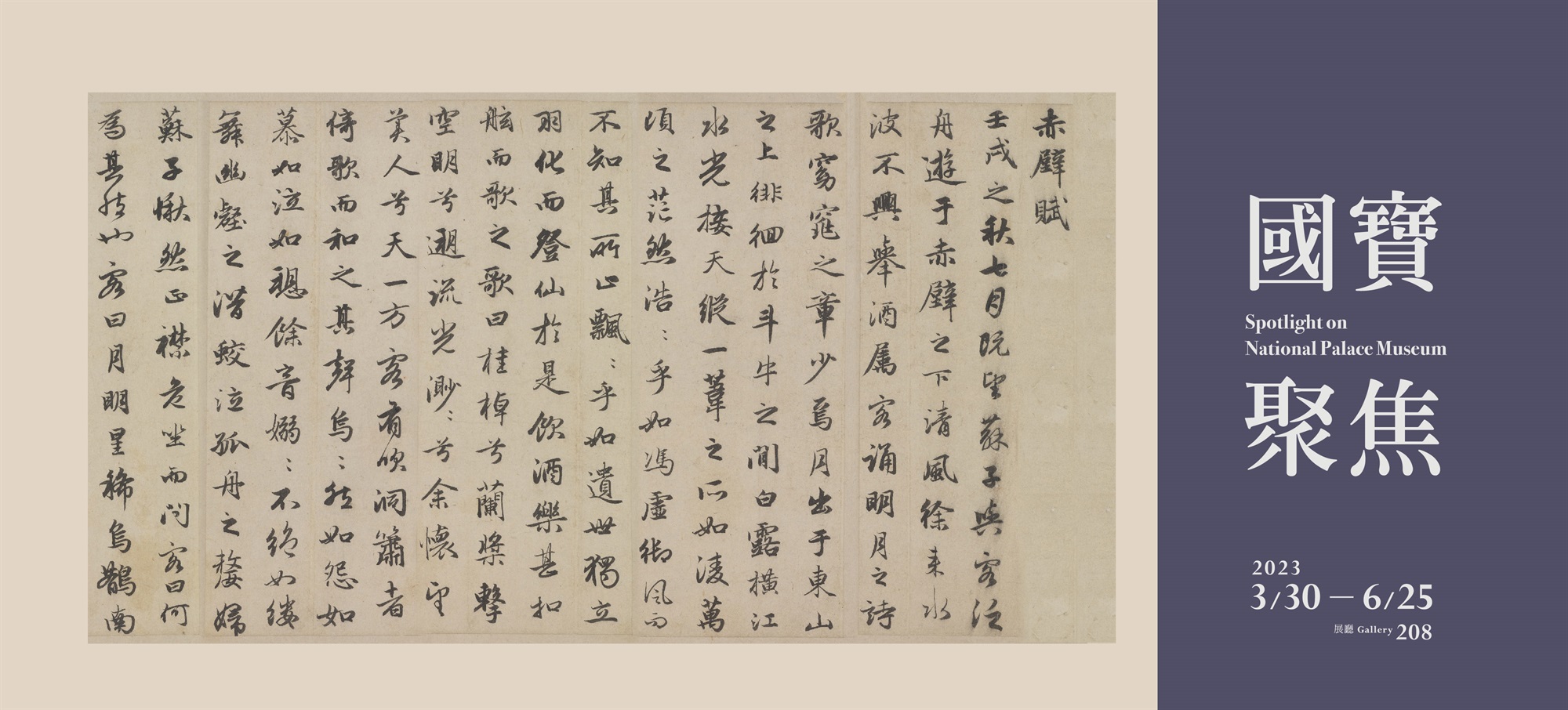Selections
Introduction
Su Shi (1037-1101), who is widely known as Su Dongpo, was a renowned figure in the fields of literature and calligraphy who lived during the Northern Song dynasty. In the third year of Emperor Shenzong’s Yuanfeng reign period (1080), Su was exiled to Huangzhou, the site of the modern city of Huanggang in Hubei province. During this period, he embarked on an overwater sojourn past an area known as Red Cliff. In the seventh and tenth lunar months of the fifth year of the Yuanfeng reign period (1082), Su penned two pieces of writing recording his trip. The first is known as “Former Ode to the Red Cliff” and the second as “Latter Ode to the Red Cliff.” These two works exerted an enormous influence on poetry, prose, calligraphy, and painting created in the eras that followed. This “Spotlight on National Treasures” exhibition presents a selection of two works of calligraphy—officially certified as National Treasures—written during the Yuan dynasty by Zhao Mengfu (1254-1322) and known collectively as “Album with Both Odes to the Red Cliff in Running Script.” Zhao Mengfu’s life, writings, and art are all discussed in this exhibition, in order to convey a sense of his deep reverence for Su Shi.
The Life and Art of Zhao Mengfu
Zhao Mengfu, of Wuxing in Zhejiang province, had the style name Zi’ang and the sobriquet Taoist of the Snowy Pines (Songxue Daoren). He was an eleventh generation grandson of Zhao Kuangyin (927-976), the founding emperor of the Song dynasty. One of Zhao’s contemporaries, Xia Wenyan, author of A Critical Treasury of Paintings (Tuhui baojian), wrote of him that, “His renown spans the five kingdoms and his name is heard beyond the four seas. His calligraphy is modelled on that of Wang Xizhi and Wang Xianzhi, while his painting is modelled on that of the Jin and Tang dynasties. Both his calligraphy and painting are uncannily exquisite.” Critiquing Zhao’s calligraphy, Wang Shizhen (1526-1590) once wrote, “One might sift through the past five hundred years or wait for the next five centuries to pass, and one might search 10,000 miles in any direction, but one will never meet a match for Zhao Mengfu. These words come from one who knows! ” Zhao’s wife, Guan Daosheng (1262-1319), whose style name was Zhongji, was a talented poet, and ci lyricist, calligrapher, and painter. Their second and third sons Yong and Yi, as well as their grandsons Lin and Feng, all carried on the family’s literary and artistic traditions.
Appreciating Zhao Mengfu’s “Album with Both Odes to the Red Cliff in Running Script”
-
Album with Both Odes to the Red Cliff in Running Script
The inscription on this album tells us that Zhao Mengfu created it in response to overtures made by his friend, Ming Yuan, in the xin-chou year of the Dade reign period under Yuan dynasty emperor Öljeytü Khan. Zhao was then serving as supervisor of the Confucian academies in Zhejiang province , during which time had had frequent interactions with literati from the region south of the Yangtze River. The album comprises twelve leaves, each of which presents a harmonious combination of calligraphy and painting. The first leaf contains a portrait of Su Shi, also known as Su Dongpo, painted in the gongbi manner. It depicts Su wearing a cord on his waist painted in heavy ink, yielding a stunning visual effect. The former and latter “Odes to the Red Cliff” follow the portrait, written with meticulous calligraphy that features characters with captivating appearances. For instance, the structure of the character for “wine” (酒) transforms repeatedly throughout the inscription, filling it with delights. The entire piece was written in a combination of regular, running, and cursive scripts, for an overall calligraphic style that is both delicate and timelessly elegant.
A Deep Reverence for Su Dongpo
Zhao Mengfu’s admiration for Su Dongpo almost certainly grew and developed over a long period of time. Appraising Su’s calligraphy, Zhao once said, “Dongpo’s calligraphy is like a great bear standing in the middle of the road—no other beast dare approach!” In fact, the NPM has three versions of the “Odes to the Red Cliff” written in Zhao Mengfu’s hand in its collection, and Zhao’s inscriptions or seal imprints can be found on three other works of calligraphy by Su Shi, including “Rhapsody on the Pine Wine of Zhongshan,” “Dongwu,” and “Speaking about a Dream in the Southern Pavilion.” Although several pieces of calligraphy purported to be Zhao Mengfu’s transcriptions of Su’s writings (namely “Su Shi’s West Lake Poems,” “Su Shi’s Archaic Poems,” and “Su Shi’s Letter on Sowing Crops”) may be inauthentic, they nevertheless shed light on the reception and influence of this subject matter.


